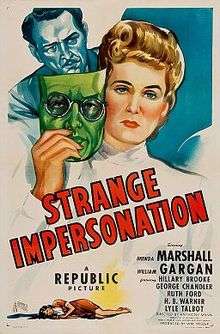Strange Impersonation
| Strange Impersonation | |
|---|---|
 Theatrical release poster | |
| Directed by | Anthony Mann |
| Produced by | W. Lee Wilder |
| Screenplay by | Mindret Lord |
| Story by |
|
| Starring | |
| Music by | Alexander Laszlo |
| Cinematography | Robert Pittack |
| Edited by | John F. Link Sr. |
Production company |
W. Lee Wilder Productions |
| Distributed by | Republic Pictures |
Release dates |
|
Running time | 68 minutes |
| Country | United States |
| Language | English |
Strange Impersonation is a 1946 American film noir drama film directed by Anthony Mann starring Brenda Marshall, William Gargan and Hillary Brooke.[1]
Plot
A disfigured woman scientist undergoes plastic surgery and then assumes the identity of a dead blackmailer.
Cast
- Brenda Marshall as Nora Goodrich
- William Gargan as Dr. Stephen Lindstrom
- Hillary Brooke as Arline Cole
- George Chandler as J W Rinse, plaintiffs' attorney
- Ruth Ford as Jane Karaski #1
- H.B. Warner as Dr. Mansfield, plastic surgeon
- Lyle Talbot as Insp. Malloy, chief interrogator
- Mary Treen as Talkative nurse
- Cay Forester as Miss Roper, interrogation witness
- Dick Scott as Detective
Release
Republic released Strange Impersonation in March 1946, three months after it was approved by the Production Code Administration. Its West Coast performance was not as good as on the East Coast, which author Max Alvarez attributes to supporting a better feature in New York City.[2]
Reception
Critical response
Film critic Glenn Erickson is positive about the film, writing, "Strange Impersonation is a fun oddity, a female version of The Scar (Hollow Triumph) (or perhaps The Woman in the Window) but without an organized crime angle. It's the kind of Cornell Woolrich yarn that depends on an unlikely but entertaining twist concept. ... The future director of El Cid and a half-dozen landmark James Stewart westerns shows a flair for dramatic confrontations. Strange Impersonation never looks cheap even though its limited cast works in just a few sets. Not surprisingly, the underlying message implies that if professional women want to be happy, they need to stop working and marry."[3] Writing in The Crime Films of Anthony Mann, Alvarez says, "Irrespective of his reservations and despite its unsatisfying conclusion, the picture is an ingenious and frenzied little thriller".[4] William Darby, who wrote Anthony Mann: The Film Career, said that the film "uneasily moves between film noir and woman's picture with the latter tendency ultimately winning out."[5]
References
Notes
- ↑ Strange Impersonation at the American Film Institute Catalog.
- ↑ Alvarez 2013, p. 75.
- ↑ Erickson, Glenn. DVD Savant, film and DVD review, December 11, 2007. Accessed: July 11, 2013.
- ↑ Alvarez 2013, p. 70.
- ↑ Darby 2009, p. 42.
Bibliography
- Alvarez, Alex (2013). The Crime Films of Anthony Mann. University Press of Mississippi. ISBN 9781617039249.
- Darby, William (2009). Anthony Mann: The Film Career. McFarland & Company. ISBN 9780786454488.
External links
- Strange Impersonation at the American Film Institute Catalog
- Strange Impersonation at the Internet Movie Database
- Strange Impersonation at AllMovie
- Strange Impersonation at the TCM Movie Database
- Strange Impersonation information site and DVD review at DVD Beaver (includes images)
- Strange Impersonation complete film on YouTube